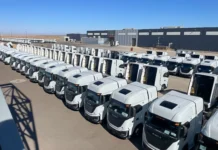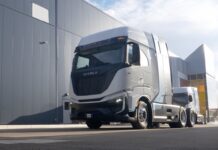
Nikola Motor Company is celebrating its first 2024 Nikola Tre fuel-cell electric semi truck deliveries to customers. I have a chance to take it on a quick drive and learn everything about it. Is this history in the making, or will this EV technology continue to struggle to make inroads into the heavy trucking industry? Here’s what it’s like, and where it’s made.
Nikola Factory
Nikola’s North American factory and offices are in Arizona. I visited the Nikola production facility in Coolidge, Arizona to see exactly how these trucks are built and what they drive like. Let’s begin with a few production stats. Nikola has been producing battery-electric (BEV) semi trucks for about a year. These trucks carry over 700 kWh of battery capacity and are meant for local/city deliveries. The new hydrogen fuel-cell electric (FCEV) semi-truck you see in this story just recently came off the line. I drove the FCEV truck with VIN 002.





The factory can currently build both BEV and FCEV trucks on the same production line. The facility is currently producing one truck per day, but the plan is to quickly ramp up to a total production capacity of 2,400 trucks per year.
Let’s Drive
This was a limited driving opportunity at the Nikola manufacturing facility. I was running in “Bob Tail” mode, meaning that I was not pulling a trailer. When I say I was in “Bob Tail” mode, it’s an actual driving mode that is selected via the center touch screen inside the truck. There are also Downhill driving and Uphill driving modes. These modes optimize the powertrain components to regenerate power or deliver power.
The FCEV day-cab semi “tractor” weighs in at around 26,000 lbs without a trailer. This is considerably heavier than a traditional diesel-powered semi-tractor that may weigh between 19,000 and 21,000 lbs depending on the configuration. A standard federally mandated semi-truck combined weight is 80,000 lbs. The electric semi trucks, like the Nikola Tre, have an exemption for a combined weight of 82,000 lbs. Still, the Nikola FCEV can legally carry several thousand pounds less than a comparable diesel truck. Naturally, Nikola is working hard to reduce the overall weight of their trucks.
The Nikola FCEV is propelled by one eAxle that contains two electric motors. This truck is a 2×6. The two motors can vary power from side to side for optimum driving, or they can be synchronized in a “locked differential” mode to deliver maximum straight-line traction. These two motors can deliver over 600 horsepower when the power is requested. This means a fully loaded Nikola FCEV can climb steep highway grades (such as I-17 from Phoenix to Flagstaff) at speeds near the posted speed limit.



This FCEV truck is equipped with five hydrogen storage tanks that provide a maximum of 70 kilograms of hydrogen capacity. Nikola says – this is good enough for an average 500 miles of loaded range. This hydrogen feeds two fuel cells that convert the fuel into electricity. This reaction also generates heat and a bit of water as an exhaust. The fuel cells require a lot of ambient air to work. The truck has an electric air compressor (or turbocharger) to push a lot of air to the fuel cells in order to create all the needed electricity. There is also a very large radiator with a loud electric fan in the front of the truck to keep the fuel cells in a proper temperature range.
That’s not all. There are two high-voltage battery packs onboard this truck for a combined 164 kWh. This is an energy buffer. The battery is either buffering the energy generated by the fuel cells before it’s sent to the electric motors, or it’s receiving energy from the motors during regenerative braking (when the truck is slowing down). There are seven regen modes available: no regen (or coast) and six progressively stronger regen modes.
After a few minutes of driving, I found this system to work seamlessly together. You either request power by pressing the skinny pedal or slow down by either releasing the accelerator or applying the brakes. Of course, this truck is equipped with redundant air brakes (primary and secondary tanks).
The front axle is suspended with leaf springs. The two rear axles have a clever electrically-controlled airbag suspension that estimates the weight of the truck when empty or loaded. This truck has a very good turning radius for its size. This is partially thanks to the wheelbase and the allowable cut (angle) of the steering.
How much does this truck cost? I asked, and Nikola is not saying exactly. Their answer is that it depends on the size of the fleet order and local government incentives. This is all they are saying at the moment.


I estimate the cost of a hydrogen fuel-cell electric semi truck to be 2.5-3.5 times more than the price of a comparable diesel semi (per unit). This is my estimate. If a new diesel tractor costs $130,000, then an FCEV truck is around $390,000. You also have to factor in the cost of ownership and fueling of the truck. If you have a mobile or permanent hydrogen fill station on site – then an FCEV fleet of trucks makes a lot more sense.
The current Nikola Tre FCEV is designed for a lifespan of 7 years and/or 700,000 miles. Nikola says some components are designed for a longer lifecycle. Future long-haul versions will have a longer designed life span.
Our first drive video is coming very soon.
















![Which is More Reliable: 3.5L EcoBoost or 5.0L V8? [Reader Question] Second-generation 3.5-liter EcoBoost engine](https://tfltruck.com/wp-content/uploads/2016/05/Second-generation-35-liter-EcoBoost-engine.jpg)
![Which Silverado Engine to Get: 5.3L or 6.2L V8? [Ask TFLTruck] 2016 chevy silverado](https://tfltruck.com/wp-content/uploads/2015/10/2016-chevy-silverado-grille.jpg)
